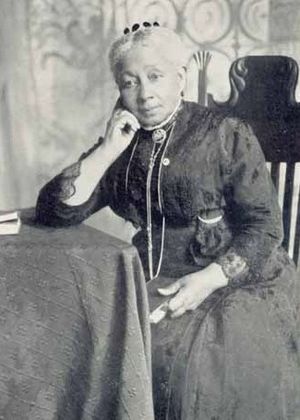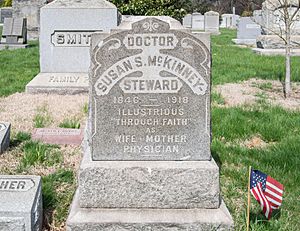Susan McKinney Steward facts for kids
Quick facts for kids
Susan McKinney Steward
|
|
|---|---|
 |
|
| Born |
Susan Maria Smith
March 1847 Crow Hill, Brooklyn, New York, U.S.
|
| Died | March 17, 1918 (aged 71) Wilberforce, Ohio, U.S.
|
| Nationality | American |
| Alma mater | New York Medical College |
| Scientific career | |
| Fields | Pediatrics, homeopathy |
| Institutions |
|
Susan Maria McKinney Steward (born March 1847 – died March 17, 1918) was an amazing American doctor and writer. She made history as the third African-American woman to become a doctor. She was also the very first Black woman doctor in New York state.
Dr. McKinney-Steward focused on helping pregnant mothers and treating childhood illnesses. From 1870 to 1895, she ran her own medical office in Brooklyn. She also helped start the Brooklyn Women's Homeopathic Hospital and Dispensary. She worked as a doctor and served on the board at the Brooklyn Home for Aged Colored People. Later, in 1906, she became the college doctor at Wilberforce University in Ohio. In 1911, she gave an important speech called "Colored American Women" at a big meeting in New York.
Contents
About Susan McKinney Steward
Her Early Life
Susan Maria Smith was born in 1847 to Anne and Sylvanus Smith. She grew up in Weeksville, which is now part of Crown Heights, Brooklyn. Susan was one of ten children in her family.
Her older sister, Sarah J. Garnet, became the first African-American female school principal in New York City. Her other sisters also had important jobs. Emma Tompkins was a teacher, Clara Brown taught piano, and Mary was a hair stylist. Susan's father worked hard as a porter and carpet cleaner. He also sold hogs, which helped his family live comfortably.
Susan loved music from a young age and learned to play the organ. She taught music and worked at a public school in Washington, D.C. for two years. She also played the organ and directed the choir at Siloam Presbyterian Church and the Bridge Street African Methodist Episcopal Church.
Her Education and Career
We don't know exactly why Susan wanted to become a doctor. But some things might have inspired her. She lost two brothers during the Civil War. This might have made her want to help prevent others from dying. Also, a serious illness outbreak in 1866 could have encouraged her to work in health care.
In 1867, Susan started studying at the New York Medical College for Women. It was very unusual for an African-American woman to attend medical school then. But her teacher, Dr. Lozier, was against slavery and helped protect Susan from negative attention.
Even though her father was wealthy, Susan chose to pay for her own education. She used money she earned from teaching at a school in Manhattan. She also earned money teaching music in Washington, D.C. and New York City. Susan chose to study homeopathy, which was a type of medicine more open to women at the time.
Susan worked very hard and was an excellent student. She was chosen as the top student in her class and graduated in 1869. After graduating, she took another course at the Long Island College Hospital.
It was hard for Susan to find a steady job at first. Also, homeopathic medicine was not always seen as important as other types of medicine. But Susan kept working. She started by treating children who were not getting enough food. Slowly, her good reputation grew, and she began treating both Black and white patients. Other doctors praised her work. She became a respected and successful doctor. In 1896, Susan was elected to the New York Homeopathic Medical Society.
Susan also wrote medical papers. In 1883, she wrote about a case where she successfully treated a woman who became sick while caring for her burned mother. Her second paper, published in 1886, was called "Marasmus Infantum." This paper focused on childhood diseases like Marasmus, which was caused by poor food and other health issues. Dr. Steward believed homeopathic treatments could help children recover better. Her knowledge of childhood diseases earned her much respect.
Dr. McKinney-Steward's medical work focused on caring for pregnant women and children. She treated patients of all backgrounds. From 1870 to 1895, she had her own practice in Brooklyn. In 1881, she helped start the Brooklyn Women's Homeopathic Hospital and Dispensary. She also worked at the Brooklyn Home for Aged Colored People.
By 1906, she and her second husband, Theophilus Gould Steward, moved to Ohio. There, she worked as the college doctor at Wilberforce University. In 1911, she went to the Universal Race Congress in London. She gave a speech there about the achievements of many African-American women. This Congress brought people from around the world together to improve relationships. In 1914, Susan gave another speech called "Women in Medicine." She wanted medical schools to allow men and women to study together. She believed this would give women more opportunities for medical training.
Susan McKinney Steward was also very active in her community and in politics. She helped create the Women's Loyal Union and served on its board. This group worked to highlight the rights of African Americans. They wanted to stop unfair treatment of any citizen. For example, from 1894 to 1895, the group asked Congress to investigate unfair violence against Black people. They also strongly supported the rights of Black educators.
Susan also served as president of her local chapter of the Woman's Christian Temperance Union. This group was founded in 1874 and worked for many social changes. They supported women's suffrage (the right for women to vote), child labor laws, and public health. This organization is still active today.
Her Family Life
In 1871, Susan married Reverend William G. McKinney. Before her marriage, she faced some financial challenges. Her marriage helped ease some of these money worries as her career grew. They had two children, Anna and William Sylvanus. In 1890, William McKinney became very ill and could no longer work. Susan then became the main provider for her family and six other relatives. William McKinney passed away in 1892.
Four years later, in 1896, Susan married again to Theophilus Gould Steward. He was a United States Army Buffalo Soldier and a chaplain. His unit was the first all-Black regiment in the U.S. Army. As a chaplain, his job was to care for the soldiers' spirits. Susan traveled with him and helped care for their injuries.
Soon after they married, she moved with him to Fort Missoula in Montana. They later moved to Nebraska in 1902 and then to Fort McIntosh in Texas in 1906. Susan practiced medicine in both Montana and Nebraska. Theophilus Steward said that Susan "entered heartily into the work among the soldiers." He also said she was an "excellent stepmother" to his children.
Her Death and Legacy
Susan McKinney Steward passed away suddenly on March 7, 1918, at Wilberforce University. Her body was brought to Brooklyn, New York, where she was buried at Green-Wood Cemetery. Her funeral was held on March 10, 1918. Many important people spoke at her funeral, including Hallie Quinn Brown, Dr. William Scarborough, and author Dr. Dubois.
In 1974, a school in Brooklyn was named "Dr. Susan Smith McKinney Junior High School" in her honor. African-American women doctors from New York, New Jersey, and Connecticut also named their medical group after her in 1976.
One hundred and forty years later, her great-great-niece, Reverend Dr. A. Louise Bonaparte, also became a doctor. She practiced medicine as a Surgical Oncologist.
In 2020, author Kaitlyn Greenidge wrote a novel called Libertie. A part of this book, "Doers of the World," is a short story based on Susan's life. It follows a girl named Libertie who watches her mother, Cathy, treat patients. Cathy is based on Susan and faces many of the same challenges. This short story won an award in 2020.
The Dr. Susan McKinney Secondary School of the Arts in Brooklyn and the Susan Smith McKinney Steward Medical Society are named after her. Actress Ellen Holly is her great-granddaughter.
See also
 In Spanish: Susan McKinney Steward para niños
In Spanish: Susan McKinney Steward para niños


